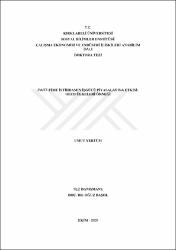Part-time istihdamın işgücü piyasalarına etkisi: OECD ülkeleri örneği
Abstract
Bu araştırmanın amacı post-endüstriyel istihdam biçimlerinden olan part-time istihdamın temel işgücü piyasası göstergeleri olan istihdam oranı, işgücüne katılma oranı, işsizlik oranı ve uzun süreli işsizlik oranı üzerindeki etkisini incelemektir. Bu amacın gerçekleştirilebilmesi için 35 OECD ülkesinin 2000 yılından en güncel veri olan 2018 yılına kadar part-time istihdam, istihdam, işgücüne katılma, işsizlik ve uzun süreli işsizlik oranları incelenmiştir. Bu değişkenler arasındaki uzun süreli ilişkinin var olup olmadığı ve varsa ilişkinin yönünün belirlenmesi için panel ARDL modeli kullanılmıştır. Gerçekleştirilen analiz sonucunda; OECD ülkelerinde part-time istihdam oranında meydana gelen %1'lik bir artış, istihdam oranını %0.10 arttırırken, işsizliği %0.84, uzun süreli işsizliği ise %0.66 arttırmakta, işgücüne katılma oranını ise etkilememektedir. OECD ülkelerindeki kadınların part-time istihdam oranında meydana gelen %1'lik bir artış, istihdam oranını %0.26 arttırırken, işsizliği %0.31, uzun süreli işsizliği ise %0.72 arttırmakta, işgücüne katılma oranını ise etkilememektedir. OECD ülkelerindeki erkeklerin kısmi süreli istihdam oranında meydana gelen %1'lik bir artış, işgücüne katılma oranını %0.03 arttırırken, işsizliği %0.30, uzun süreli işsizliği ise %0.51 arttırmakta, istihdam oranını ise etkilememektedir. Buradan hareketle 2000-2018 yılları için OECD ülkelerinde part-time istihdam oranın meydana gelen bir artışın istihdam oranından fazla işsizlik yarattığını söylemek yerinde olacaktır. The aim of this study is to examine the relationship between part-time employment, which is one of the post-industrial forms of employment, with the basic labor market indicators such as employment rate, labor force participation rate, unemployment rate and long-term unemployment rate. Part-time employment, employment, labor force participation, unemployment and long-term unemployment rates of 35 OECD countries from 2000 to 2018, which is the most recent data, have been analyzed in order to achieve this goal. The panel ARDL model was used to determine whether there is a long-term relationship between these variables and the direction of the relationship, if there is any. As a result of the analysis; a 1% increase in the rate of part-time employment in OECD countries increases the employment rate by 0.10%, unemployment by 0.84% and long-term unemployment by 0.66%. A 1% increase in the part-time employment rate of women in OECD countries increases the employment rate by 0.26%, while increasing unemployment by 0.31% and long-term unemployment by 0.72%. A 1% increase in the part-time employment rate of men in OECD countries increases the labor force participation rate by 0.03%, while unemployment increases 0.30% and long-term unemployment by 0.51%. Based on this, it would be appropriate to say that an increase in the rate of part-time employment creates more unemployment than the employment rate.
URI
https://tez.yok.gov.tr/UlusalTezMerkezi/TezGoster?key=9MiDp3x86xrwjpi5-14w-Uy8slq6OpZXNo9DHXJd1ep2GsPUVv9BHJndj47E7mm_https://hdl.handle.net/20.500.11857/1520
Collections
- Tez Koleksiyonu [311]



















